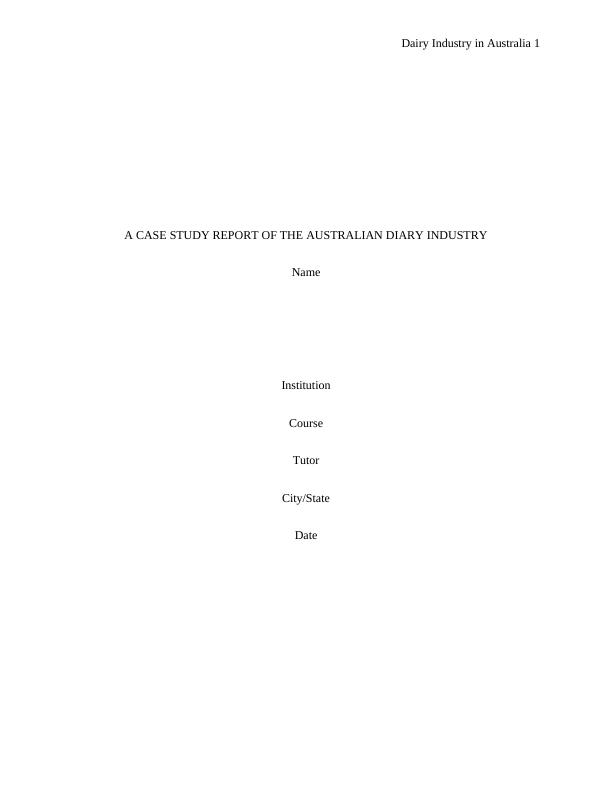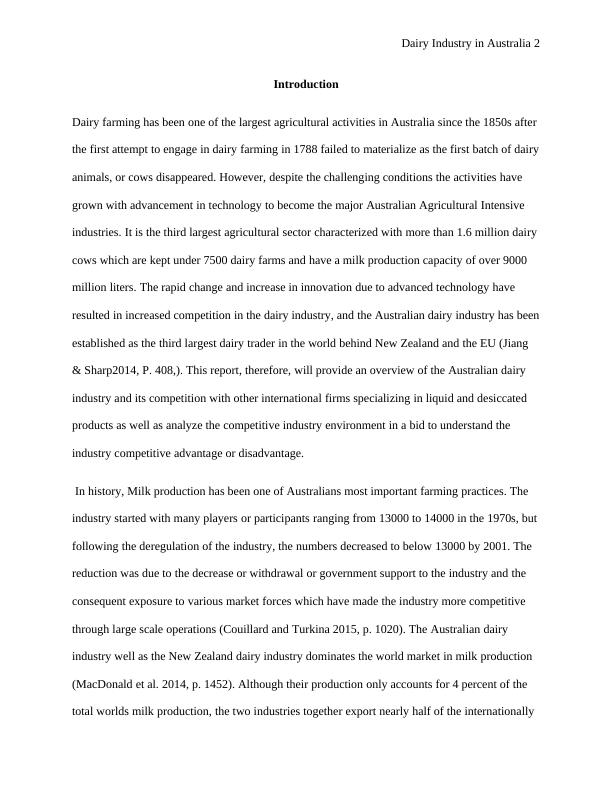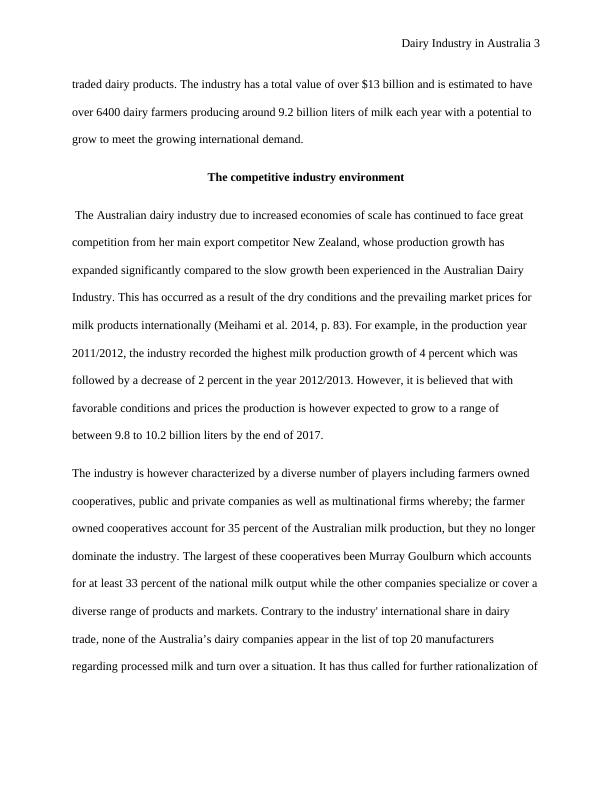Dairy Industry in Australia: Case Study
13 Pages2765 Words104 Views
Added on 2020-03-07
Dairy Industry in Australia: Case Study
Added on 2020-03-07
ShareRelated Documents
Dairy Industry in Australia 1A CASE STUDY REPORT OF THE AUSTRALIAN DIARY INDUSTRYNameInstitutionCourseTutorCity/StateDate

Dairy Industry in Australia 2Introduction Dairy farming has been one of the largest agricultural activities in Australia since the 1850s after the first attempt to engage in dairy farming in 1788 failed to materialize as the first batch of dairyanimals, or cows disappeared. However, despite the challenging conditions the activities have grown with advancement in technology to become the major Australian Agricultural Intensive industries. It is the third largest agricultural sector characterized with more than 1.6 million dairycows which are kept under 7500 dairy farms and have a milk production capacity of over 9000 million liters. The rapid change and increase in innovation due to advanced technology have resulted in increased competition in the dairy industry, and the Australian dairy industry has beenestablished as the third largest dairy trader in the world behind New Zealand and the EU (Jiang & Sharp2014, P. 408,). This report, therefore, will provide an overview of the Australian dairy industry and its competition with other international firms specializing in liquid and desiccated products as well as analyze the competitive industry environment in a bid to understand the industry competitive advantage or disadvantage. In history, Milk production has been one of Australians most important farming practices. The industry started with many players or participants ranging from 13000 to 14000 in the 1970s, butfollowing the deregulation of the industry, the numbers decreased to below 13000 by 2001. The reduction was due to the decrease or withdrawal or government support to the industry and the consequent exposure to various market forces which have made the industry more competitive through large scale operations (Couillard and Turkina 2015, p. 1020). The Australian dairy industry well as the New Zealand dairy industry dominates the world market in milk production (MacDonald et al. 2014, p. 1452). Although their production only accounts for 4 percent of the total worlds milk production, the two industries together export nearly half of the internationally

Dairy Industry in Australia 3traded dairy products. The industry has a total value of over $13 billion and is estimated to have over 6400 dairy farmers producing around 9.2 billion liters of milk each year with a potential to grow to meet the growing international demand.The competitive industry environment The Australian dairy industry due to increased economies of scale has continued to face great competition from her main export competitor New Zealand, whose production growth has expanded significantly compared to the slow growth been experienced in the Australian Dairy Industry. This has occurred as a result of the dry conditions and the prevailing market prices for milk products internationally (Meihami et al. 2014, p. 83). For example, in the production year 2011/2012, the industry recorded the highest milk production growth of 4 percent which was followed by a decrease of 2 percent in the year 2012/2013. However, it is believed that with favorable conditions and prices the production is however expected to grow to a range of between 9.8 to 10.2 billion liters by the end of 2017.The industry is however characterized by a diverse number of players including farmers owned cooperatives, public and private companies as well as multinational firms whereby; the farmer owned cooperatives account for 35 percent of the Australian milk production, but they no longer dominate the industry. The largest of these cooperatives been Murray Goulburn which accounts for at least 33 percent of the national milk output while the other companies specialize or cover adiverse range of products and markets. Contrary to the industry' international share in dairy trade, none of the Australia’s dairy companies appear in the list of top 20 manufacturers regarding processed milk and turn over a situation. It has thus called for further rationalization of

Dairy Industry in Australia 4the larger Australian dairy processors within the Australian dairy processing landscape to compete with international giants such as Friesland Camping and Fonterra.Figure 1: Dairy production progression in Australia (Adopted from Montoya et al. 2014, p. 850) From the graphical data above, New Zealand has a much higher production as compared to the Australia dairy industry which has a more progressive production growth as compared to a declining production of the Australian industry. To make the industry more competitive, the Australian Dairy Industry believes that the government should focus on trade development by improving market access through the establishment of partnerships with trading partners such as China and other emerging Potential markets in the Middle East as well as in the South East Asia.This would not only mean that the government should remove restrictive tariffs and quotas but also invest in solving trade barriers related to technical market access.

End of preview
Want to access all the pages? Upload your documents or become a member.
Related Documents
1003MKT - Dairy Industry in Australialg...
|8
|1317
|126
Accounting Principles for A2 Milk and Bellamy’s Australia Ltdlg...
|14
|3566
|127
The Australian Dairy Industry : Assignmentlg...
|11
|2164
|72
International Strategic Managementlg...
|12
|800
|337
Expansion of Dairy Products from Netherlands to Fiji Islandslg...
|3
|785
|50
Prime Goals of Farm Businesslg...
|15
|5049
|55
